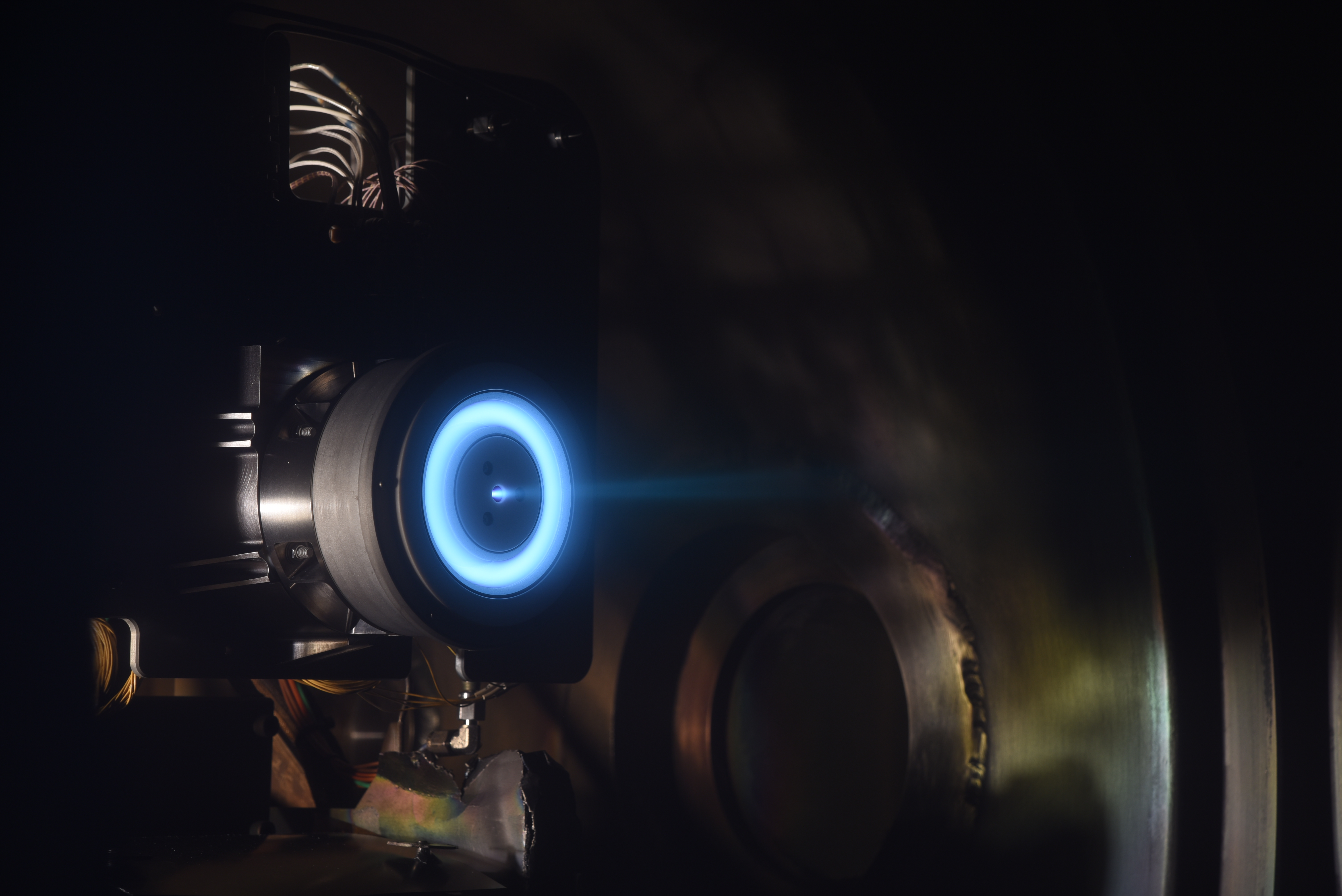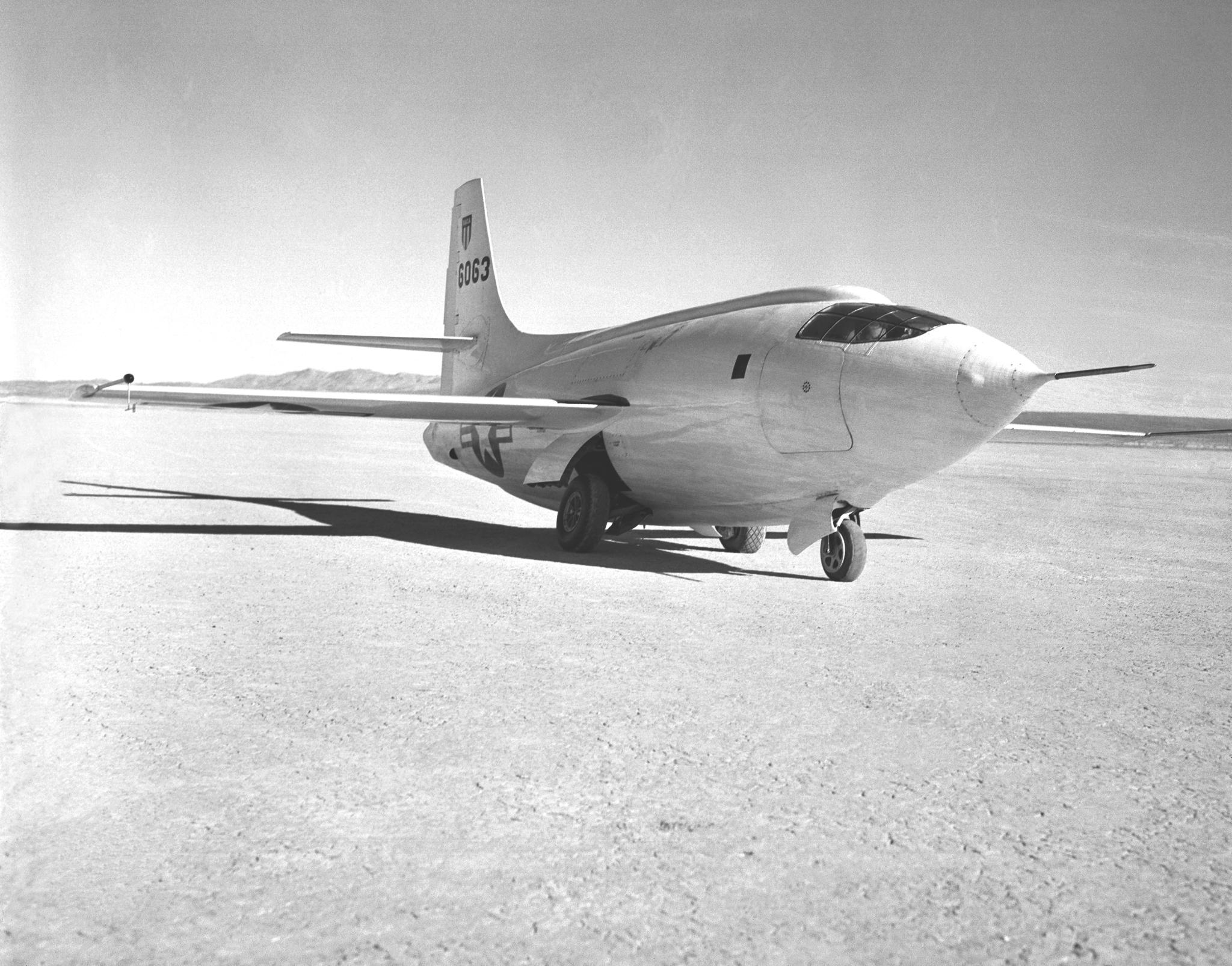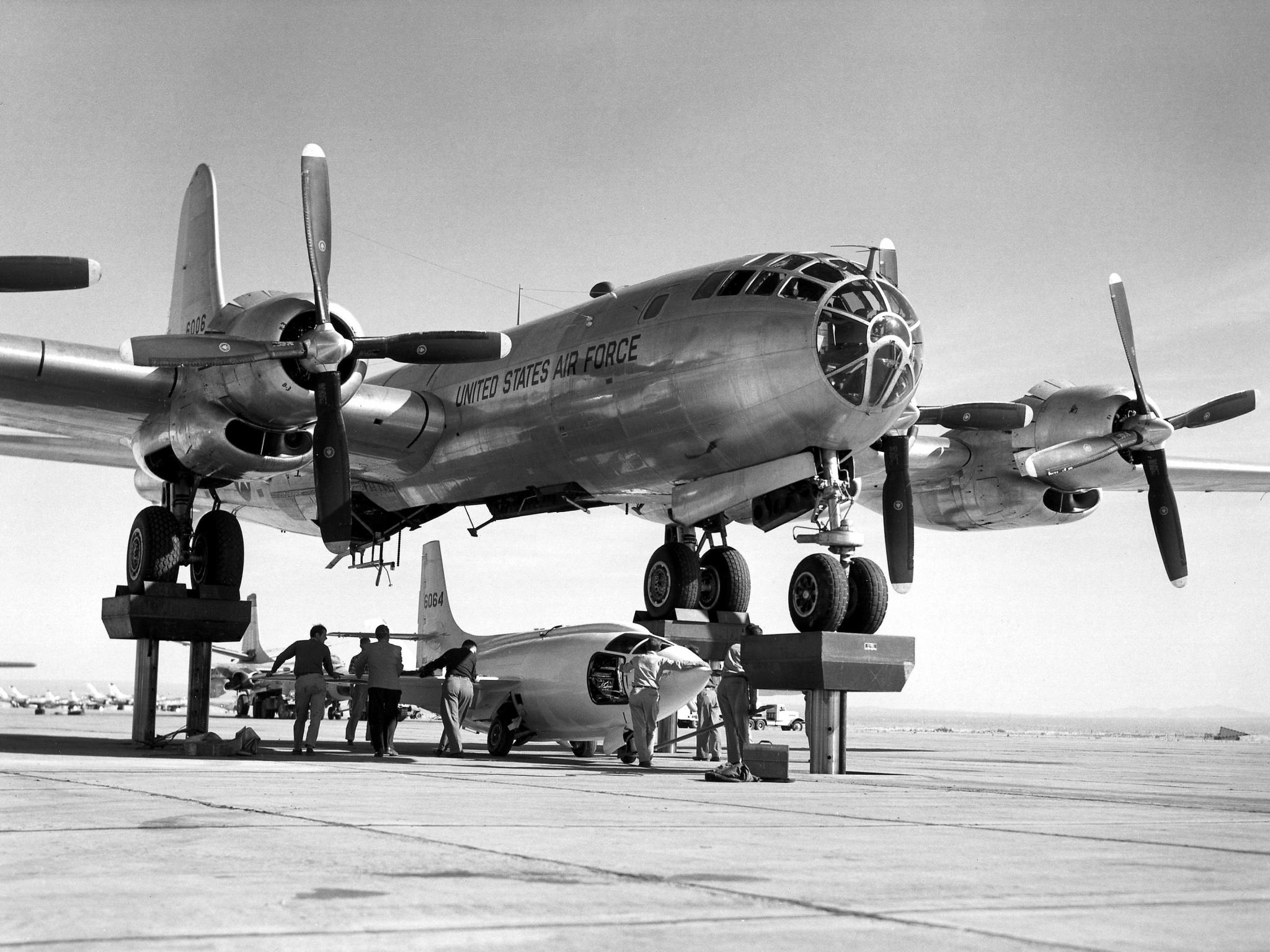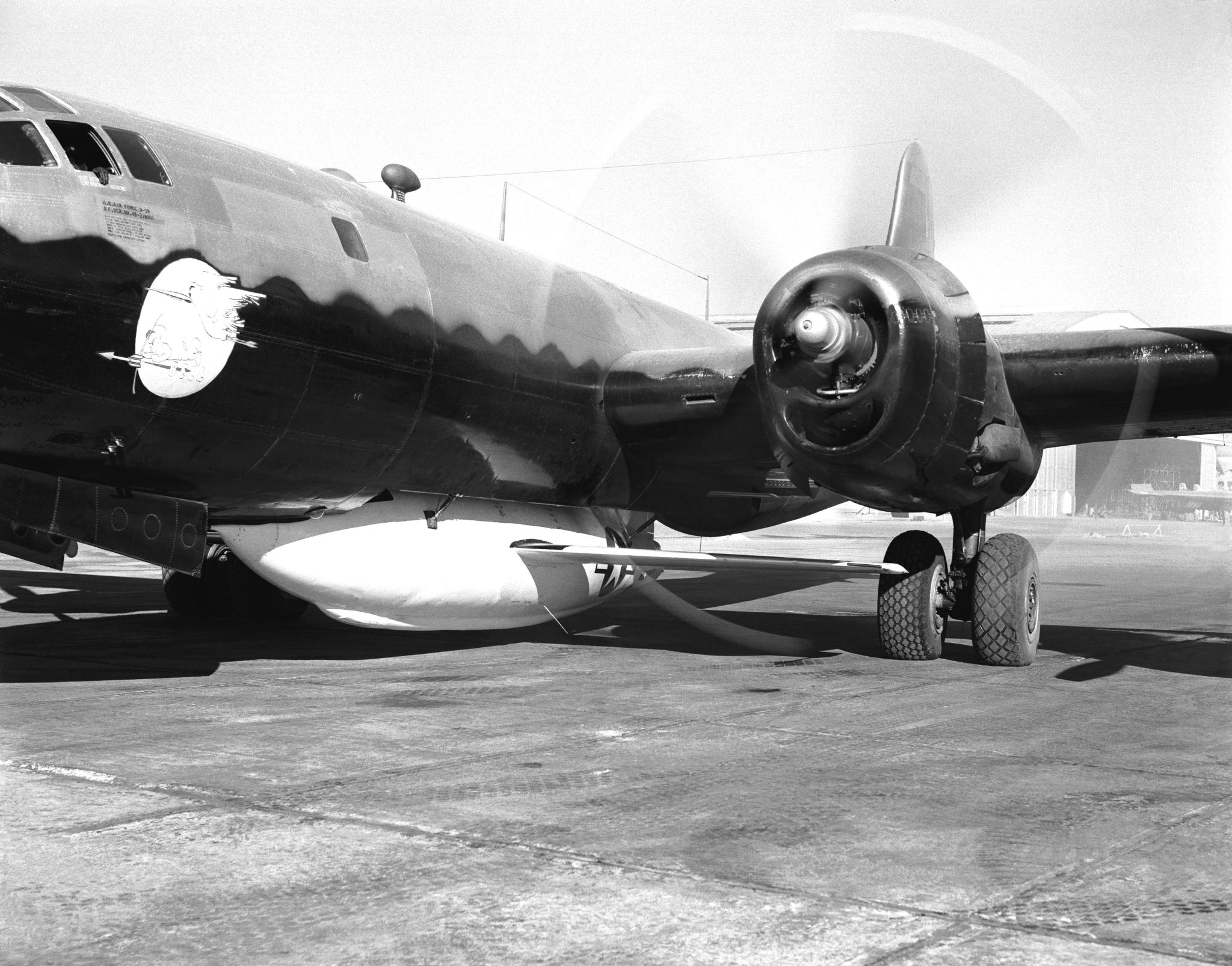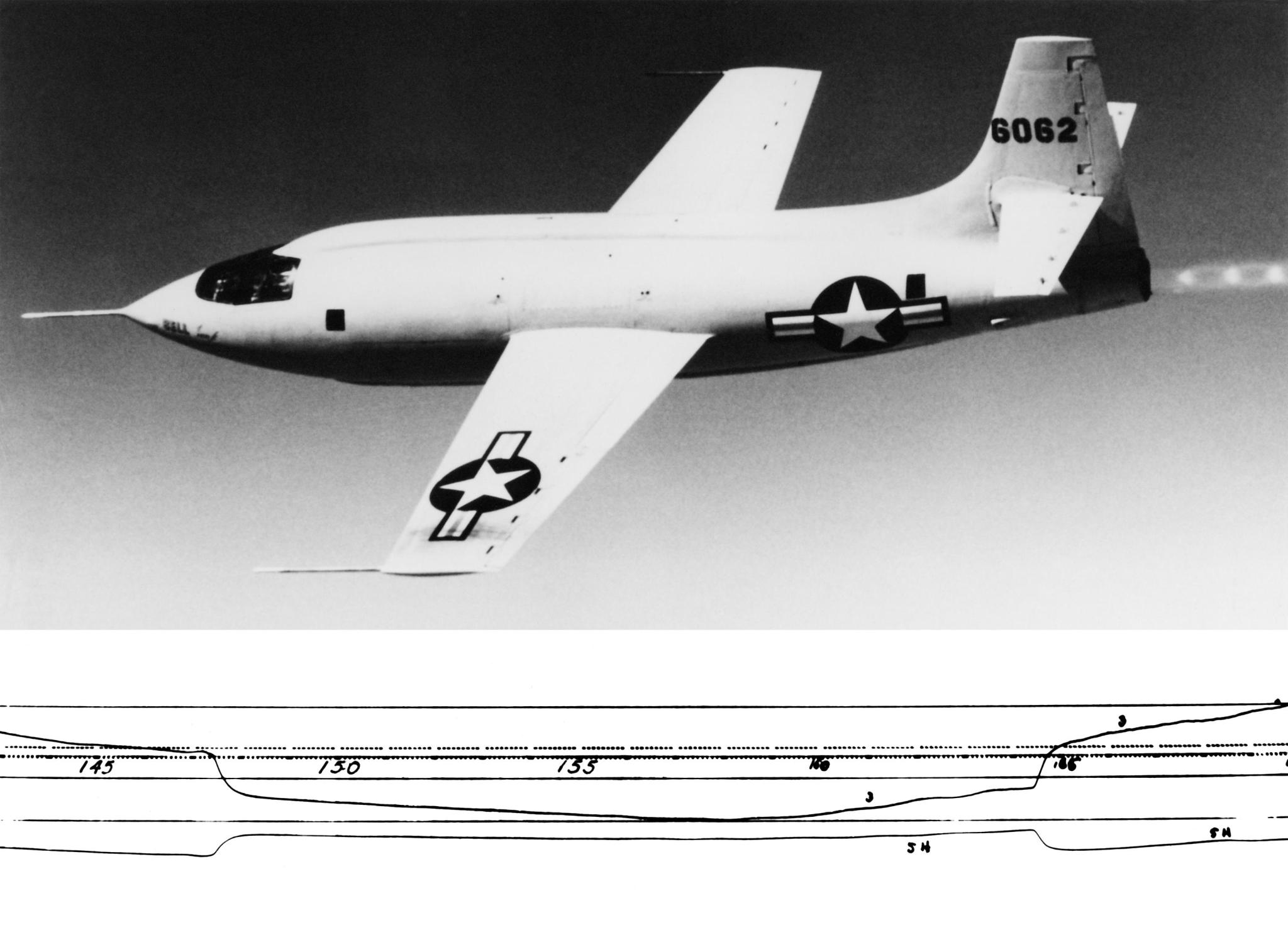The second generation X-1s used the same wing, horizontal tail, and XLR-11 rocket engine as the first generation aircraft, with a new cylindrical fuselage just over 4 1/2 feet longer than the original design. This was the maximum length that could be carried by a B-29 or B-50 launch aircraft. The cockpit design was also changed to a “stepped” canopy, allowing the pilot to enter from the top, instead of the side hatch on the original X-1. A more significant change was the fuel system. The new aircraft used a low-pressure turbopump, which eliminated the heavy spherical liquid oxygen (LOX) and alcohol tanks. The new, larger tanks now conformed to the fuselage shape. As a result, the airplane’s calculated maximum performance had increased to Mach 2.47 at 70,000 feet.
Four of the second generation X-1s were originally to be built by Bell Aircraft: the X-1A for dynamic stability tests; the X-1B for air load research; the X-1C for armaments tests using a .50 cal. machine gun in the nose and a gun sight for the pilot; and the X-1D for heat transfer research. The X-1C was canceled while in the mockup stage.
The X-1D (serial number 48-1386) was the first of the second generation aircraft to be delivered, arriving at Edwards Air Force Base, CA, in July 1951. The first glide flight was made on July 24, by Bell test pilot Jean Ziegler. The flight was successful, but after touchdown the nose gear was damaged, requiring several weeks of repair. The aircraft was then turned over to the Air Force, and Lt. Col. Frank Everest was assigned as project pilot. Its first powered flight was scheduled for August 22, 1951. The launch was aborted, however, due to the loss of nitrogen pressure. Everest attempted to jettison the propellant, triggering an explosion and fire. The X-1D was jettisoned and destroyed on impact. The X-1D accident board theorized that a fuel leak had created an explosive mixture of air and alcohol, which was ignited by a spark from the X-1D’s radio or an external power source.
Following a captive flight on 9 November 1951, both aircraft were destroyed by fire during defueling.
The X-1A (serial number 48-1384) was not delivered to Edwards until January 7, 1953. Ziegler made the first glide flight on February 14, 1953. After a second glide flight six days later, he made the first powered flight on February 21. The Phase I contractor flights continued through April, when the aircraft was returned to Bell for modifications. The aircraft was returned to Edwards in October 1953, and began a series of flights at higher Mach numbers. Maj. Charles E. “Chuck” Yeager reached a speed of Mach 2.44 at 74,200 feet on December 12, only a few days before the 50th anniversary of the first powered flight. The aircraft began to roll to the left as it reached maximum speed. Yeager tried to counter with right aileron and rudder, but the X-1A began to roll to the right. The aircraft then tumbled out of control, throwing Yeager around in the cockpit, and rendering him unconscious. He finally revived at about 29,000 feet, with the X-1A in an inverted spin. Despite being groggy, Yeager was able to recover and land back at Edwards, without the help of chase planes.
The Air Force decided not to make any additional high Mach flights with the X-1A, due to the instability. Rather, the X-1A would be used for very high altitude flights by Maj. Arthur Murray. A series of flights were attempted during the spring and summer of 1954, but only four were successful. On two of these flights, including the record-setting flight of August 26, 1954, which reached 90,440 feet, similar instability occurred. This was not as severe as on Yeager’s flight, due to the lower speed and higher altitude. The loss of control was traced to a decrease in directional stability, which allowed inertial coupling to occur. The X-2 and X-3 research aircraft were also affected by inertial coupling.
The X-1A was turned over to the NACA for high-altitude/high-Mach flights in September 1954, and were sent to Bell Aircraft for modifications. The X-1B (serial number 48-1385) made several Air Force pilot checkout flights, and was then turned over to the National Advisory Committee for Aeronautics on December 3, 1954. Like its sister ship, the X-1B underwent modifications for its research role.
The X-1A returned to Edwards in mid-1955, and made its first NACA flight on July 20. Joe Walker reached a speed of Mach 1.45, and landed safely. The next NACA X-1A flight was scheduled for August 8. During the countdown, an explosion occurred in the aircraft. The B-29 launch aircraft could not be landed with the damaged X-1A aboard, so the rocket plane was jettisoned and destroyed on impact.
The X-1A was the fourth rocket plane destroyed by explosions. The others were the X-1D, the X-1-3, and the X-2 #2. The investigations following each crash found no common factor in the accidents. After the X-1A crash, the debris was brought in from the desert and laid out on a hangar floor. The X-1B which had returned from modifications only a week before the loss of the X-1A, was parked next to the debris. When the X-1B’s liquid oxygen (LOX) tank was examined, tricresyl phosphate (TCP) was found in both the LOX tank and the LOX lines to the engine. TCP was used to treat the leather gaskets in the tank and LOX lines. Tests indicated that when the leather gaskets were in contact with LOX, the TCP was impact sensitive. The shock of the tanks pressurizing would, under certain conditions, cause it to explode. A reexamination of the four accident indicated that TCP explosions were responsible in each case. The leather gaskets were removed from the X-1B and the surviving X-2, and no further explosions occurred.
With the cause of the explosion identified, work on the X-1B resumed. A total of 300 thermocouples were installed on the aircraft for data on aerodynamic heating. The first NACA flight in the X-1B was made on August 14, 1956 by John B. McKay. By January 1957, a total of two checkout flights and four heating flights had been made by McKay. The data was considered representative of what future Mach 2 aircraft might encounter.
The aircraft then undertook a series of research flights for high-Mach number stability and control data. These were made beginning in May 1957 and continuing through August. A total of seven flights were made in the series. The X-1B was then modified for tests of a reaction control system (RCS). Several hydrogen peroxide rockets were mounted on a wingtip, the aft fuselage and the tail to provide control when the dynamic pressure was too low for conventional aerodynamic controls. This was to gain experience for the upcoming X-15 program.
McKay made the first RCS checkout flight on November 27, 1957. Two more flights were made in January 1957, before rains closed the lakebed until spring. The plan was to resume flights at low aerodynamic pressures. A preflight inspection found cracks in the LOX tank, which would require a new tank be built. This would have been too expensive, and the aircraft was grounded. The RCS flights were transferred to an F-104, while the X-1B was sent to the Air Force Museum.















